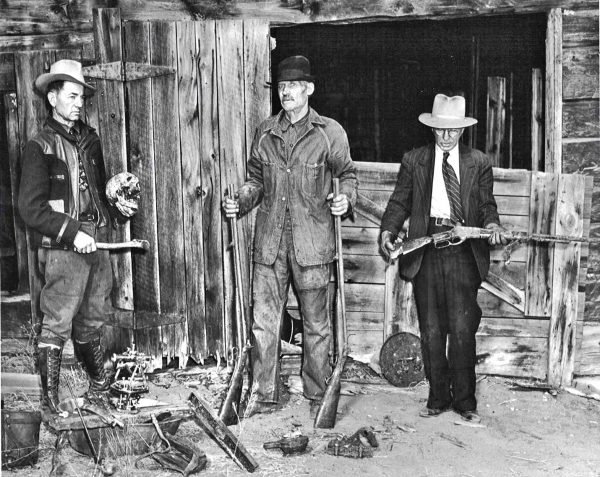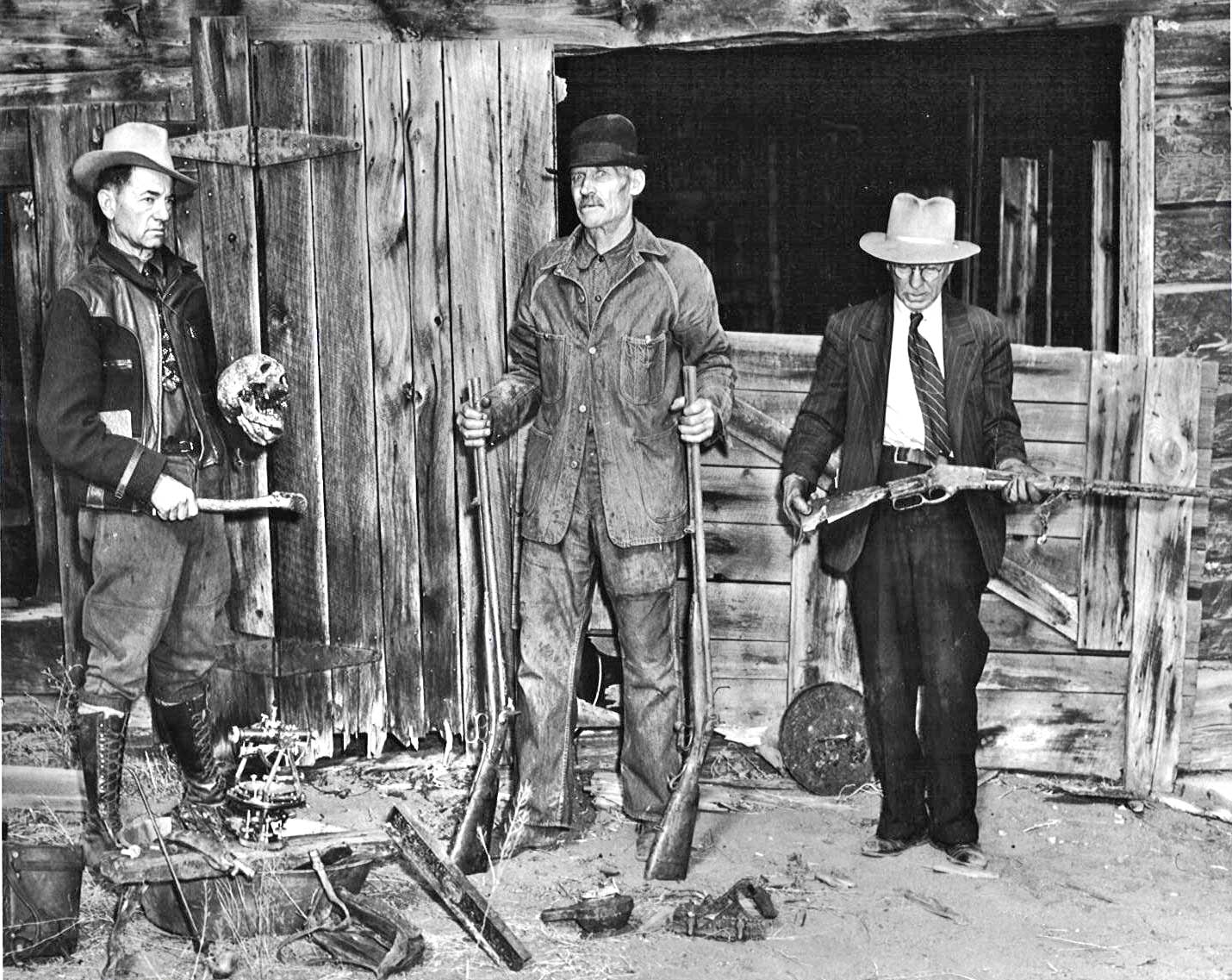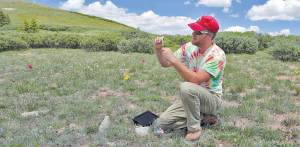by Jan MacKell Collins
In October of 1944, two GI’s from Peterson Air Force Base were hunting near Lake George. One of them, Master Sergeant Francis Brahler, hiked up to a remote granite outcropping. A reflection from the sun caught his eye. Further inspection revealed an actual glass window in the rock, completely hidden from view below. Brahler managed to slide the glass to one side, shinnied through the window, and discovered a secret cave dating back a half century.

The cave Brahler found solved one of Park County’s greatest mysteries. It all began in 1892 when a local rancher, Gottlieb Fluhmann, vanished into thin air. Fluhmann had immigrated from Switzerland in 1866. A skilled surveyor and gunsmith, he had taken up ranching by 1876 in the Puma Hills some three miles north of Lake George. But Fluhmann appeared “peculiar” to his neighbors. For starters, he was only 5 feet, 4 inches and spoke broken English with an odd accent. He also coddled his cattle and even named them. His modest cabin and outbuildings were well kept, but Fluhmann’s ranch was located off the beaten path. Few seemed to visit him, an exception being a young boy named Dan Denny.
The outcast Fluhmann mysteriously disappeared in late 1892, shortly after hinting that he might kill himself or hide where he would never be found. The Fairplay Flume first reported on Fluhmann’s vanishing act in December. Search parties turned up nothing and in February Henry Krebill, who had been looking after Fluhmann’s cattle, was appointed executor of his estate. His 200-acre ranch was auctioned off in May and included around 156 cattle, a horse and saddle, tools and household furnishings. Fluhmann’s nephew in Crested Butte heard about the auction in the papers and traveled to Lake George to join another search. But all searches had been exhausted by March of 1894 and Gottlieb Fluhmann was officially declared dead.
Fluhmann’s name was next brought to the surface in 1895, when fellow rancher Benjamin Ratcliff killed three members of the local school board. Ratcliff and his family first came to the Lake George area in about 1876, settling some 30 miles from Fluhmann. The Ratcliffs had three children, but a fourth child and Ben’s wife, Elizabeth, died during childbirth in 1882. Shortly afterward, Ratcliff’s five-year-old daughter, Lizzie, broke her hip and developed a severe limp.
The closest school was several miles away. Ratcliff wrote a letter to the school board requesting that either the school be moved closer to his ranch or that he receive a tutor or schoolbooks on loan to teach his children at home. When the board denied these requests, a frustrated Ratcliff sent Lizzie and his other daughter, Lavina, to be schooled by Elizabeth’s relatives in Missouri. His son, Howell, remained at the ranch.
Lizzie and Lavina returned home in 1893. The following year, one Lincoln F. McCurdy was appointed to the school board at nearby Bordenville. Soon afterward, Ratcliff received a letter from his neighbor, Susan Crocket. The note claimed that McCurdy was spreading a ghastly rumor that Lizzie, now a teenager, walked funny because she was pregnant by her own father.
Ratcliff waited until the annual school board meeting on May 6, 1895 to unleash his fury. As board members McCurdy, Samuel Taylor and George Wyatt met at the school, a heavily armed Ratcliff stormed the building and shot each man. McCurdy and Taylor died instantly, but Wyatt lived long enough to describe what happened. Meanwhile, Ratcliff turned himself in at Como.
Ratcliff’s attitude during his trial only furthered his reputation for having “a very quarrelsome disposition.” He stubbornly told the Silver Cliff Rustler that “he did just right, and if he was younger he would get some more of the people that had helped to ruin his name … He does not seem to fear the results of his deeds.” The Colorado Democrat next reported that Gottlieb Fluhmann had argued with Ratcliff over a cattle deal a short time before he disappeared. “It is now suspected that Benjamin Ratcliffe [sic], the Park County murderer, is responsible for the disappearance of a well-to-do ranchman named Fluman [sic] some three years ago,” the Democrat confirmed, adding that since Fluhmann’s disappearance Ratcliff “has appeared to be uneasy and has always been heavily armed.” The Rocky Mountain News followed the Democrat’s lead, claiming that Ratcliff “was the last man seen with Fluhmann and the last man who saw Fluhmann.”
If Ratcliff knew anything about Fluhmann’s disappearance, he took it to the grave when he was hanged for his crime in February of 1896. Fluhmann was pretty much forgotten – until his cave was found on that day in 1944. Inside, Francis Brahler found a room measuring roughly 35 feet deep, five feet high and five feet wide. There was a Dutch oven, and some wooden shelves held a meerschaum pipe, cooking utensils, ammunition, a telescope, lamps and kerosene, a surveyor’s transit and a leather bag. Pack rats had woven several smaller items into a large nest. Brahler and his friend took some of the items, returning for more the next day.
This time, Brahler noticed something else inside the dark cave: the skulls of a man and a dog lay together near the center of the room, alongside a .36 Marlin rifle. The soldier reported his find to authorities, and Park County Sheriff Sylvester Law, Dan Denny and Fairplay Flume reporter Everett Bair came to inspect the cave. A passport confirmed the body was that of Gottlieb Fluhmann, as well as letters from his sister and nephew. Fluhmann’s skull, the Marlin, two fancy flintlock rifles and several other items were removed for further inspection.
The Marlin was of particular interest because the rifle butt had been shattered by a bullet. From the angle at which the bullet had entered the wood, Sheriff Law theorized the weapon was being held when it was struck. Others pointed out that Fluhmann would have surely applied his gunsmithing skills to the damaged stock had he been alive, leading to speculation that he was likely killed from the same bullet. But who was he hiding from, and who shot him?
Both the Flume and the Colorado Springs Gazette revisited the old news of the grudge between Fluhmann and Ratcliff, repeating Dan Denny’s recollections that Fluhmann was “quick to pick up imaginary insult or attempt to cheat him” and was “of a ‘flighty’ temperament and troubled by the thought that someone was stealing his cattle periodically.” According to Denny, Fluhmann’s paranoia led the rancher to always be armed while out tending his herd, and the initial insinuation was that Fluhmann feared Ratcliff enough to go hide out in a remote cave. In a later article for Real Detective magazine, however, Bair overstepped his reporter boundaries. Ratcliff was presented under the fictitious name of Frank Burke, a “gunman” who threatened Fluhmann. Bair further alleged that both men disappeared at the same time, theorizing that “Burke” found Fluhmann and shot him to death through a natural skylight high above the cave.
More tales circulated with time. One went that Ratcliff once taunted Fluhmann in public, claiming to be eating a juicy steak from one of the Swiss man’s beloved cows. Another story was that Ratcliff’s two sons were caught trespassing on Fluhmann’s ranch (Ratcliff only had one son). In that story, the boys teased Fluhmann and spit on his horse. Fluhmann then chased the boys off and fired shots over their heads. The incident resulted in a death threat from Ratcliff, delivered by his daughter with the promise it would be carried out in the fall of 1892.
Despite the lack of hard evidence, Ratcliff has generally been blamed for killing Gottlieb Fluhmann. Modern forensics might tell more, if only the whereabouts of the rifle butt or even the location of Fluhmann’s grave were known. As for the contents from his cave, the Flume confirmed in 1944 that “The debris has been well sorted and gleaned by the Sheriff and his helpers.” In 1973 one of Fluhmann’s handmade flintlock rifles surfaced in Fairplay, and a resident of Alma owns his sewing kit. The rest of his belongings have scattered to the wind.
In 1976, the Park County Local History Archives added Fluhmann’s cave to the Colorado Inventory of Historic Structures and Sites, and the entry’s conclusion is quite poignant: “To this day no one really knows what happened to him.”
Jan MacKell Collins is an author and former director of the Cripple Creek District Museum. She now lives in Arizona but still enjoys writing about Colorado’s fascinating history.




I am Benjamin Ratcliff’s great-great grandaughter and I wish I had found this article sooner.
Please write about Either Fluhmann, or Ratcliff, but NOT both together.
You’re accurate until the seventh paragraph when you start copying Midge Harbour – who plagiarized a September 1971 article from (ironically) Colorado Magazine, called ‘The Death Cave’, word for word, when she wrote ‘The Tarryall Mountains and The Puma Hills” in 1982. However, I appreciate that you’ve spelled his name correctly and gotten the number, genders and names of his children right.
The photo was Originally published September 1975 in True West Magazine. I sent Randy and Brenda (of *real business name* M Lazy C Ranch) the article, asking them to please stop using this false association as a featured horse ride to the cave.
You left out Dan Denny’s statement – that he Talked to men who had Seen Fluhmann carrying the rifle with the damaged stock Before he disappeared.
Proofread your own chronology – the girls were in Missouri until 1893. How could Lavina have harmed Fluhmann in 1892?
There is not one word in the 253 page transcript of Ratcliff’s trial about Fluhmann.
From the Fairplay Flume, January 12, 1893: [Neighbors speaking about Fluhmann] “was a peculiar character and has been known to talk of making away with himself.” And, April 20, 1893: “He remarked to different parties that when he did disappear, they would never find him.”
If you’ve ever traveled Tarryall Road (before it was recently paved) you’d realize that the 30 miles between their properties is quite an bone-jarring trip in a 4 wheel drive truck, let alone on horseback or wagon, for Ratcliff to go harass a neighbor. Not to mention he wouldn’t even have the time to Think about Fluhmann while trying to manage the pain of a damaged hip, dislocated shoulder and kidney stones, along with being a single father training a teenaged boy in ranching, and working his hayfields.
In 2011, Colorado Central Magazine published a review by the late Ed Quillen of our family’s book, “The Legend of Benjamin Ratcliff”, of which I was a co-researcher. The other historian and I also advised on two other books, “South Park Perils” and “Parked In The Past” (that author posted pictures of a summer 2014 visit to the cave on her website). I also contributed to (uncredited by request) the article on Wikipedia, but have no control over the links.
Correcting your dates: In the transcript, Benjamin states that he [and Elizabeth] came to Park County in 1871, not 1876. They apparently kept to the northern end of the road, doing business in Jefferson and Fairplay, not ever in Lake George at the southern end.
The Legend author once asked a local clerk if she’d ever heard about Ratcliff, and the high schooler said “Oh, yeah. He’s the guy that killed the guy in the cave.”
That’s ALL kids know? From exaggerated articles like this?
The TRUTH regarding the actual murders, and Years of research, with citable sources, isn’t enough?
Nearly 120 years ago, Ratcliff fired a warning shot into the schoolhouse floor demanding an apology to protect the honor of his family. I have to google him frequently, because I find other bloggers such as yourself, who get a whiff of this story and feel the need to embellish.
Enough already.
If it was Your relative people wrote lies about, wouldn’t you retort too?
It’s no secret that the Ratcliffs are sensitive about this issue, as I have seen other online posts. I don’t blame them, but history is history. In fact I do have a few family skeletons in my closet too, but have never seen the sense in getting upset about it. They have nothing to do with the person I am today.
Alternatively the descendants of Mr. Fluhmann, no matter how distant, might appreciate that someone still cares about him enough to tell his story. Most unfortunately the most interesting thing about him is his death.
Wendy presents some very sound sources, some of which I could not find from over here in Arizona. Also I was not aware of the book, which I would love to read sometime. Midge Harbour’s article was not among the sources I used. The sources I did find were the basis of the dates, times, people and places I wrote about in the article. Much of my research was done on Ancestry.com, which presented a few original documents I was able to use to ascertain information on Ratcliff and Fluhmann. Some of them date to the first time I researched Fluhmann’s death in 2003 during the Hayman fire. I did consult with the Park County coroner, also the Park County Historical Society and others while writing this article, and made every effort to find the truth.
Unfortunately there was not enough room to write every little detail I discovered, and I made a point of leaving out much of the hearsay various historians have enjoyed using to make the story juicier. There is no question that over time, some of the facts have mixed with fiction.
As the author of well over 2,000 articles and several books, I can say without doubt that as far as I am concerned, Mr. Fluhmann and his unfortunate death has been put to rest. I have no plans to write about him again. Hopefully this makes Wendy feel better.
Best regards,
Jan
I live in Fluhmann’s cabin. From my front porch, I can see the rock face where the cave is hidden. I renovated the cabin in 1996 and added a room to the back. The cave is actually on the National Forest and is very small. It is really just a wide crack in the cliff. Although you can now see the cabin from the front of the cave, you would not have been able to see it in the 1890’s. I dismantled the logs and moved the cabin up the hill to take advantage of the location near the pond. For many years before that, it had been used as a shed and a tractor had been parked inside. Eventually the dirt roof caved in. That was how I found it.
I have made a few phone calls trying to find out where the bones that were found in the cave were finally buried. For all I know they could still be in a police evidence room somewhere. I hear bits and pieces often from locals. One of my neighbors who was in his 80’s said that as a boy, he knew people who actually knew Fluhmann. I would like to know the truth of what happened, but as the years go by, that becomes less and less likely.
There are also a number of sites where it is clear that someone was digging to find minerals or gems. Between my cabin and Mule Creek (M Lazy C) Ranch, there was once a tiny mining town. I think it may have had two buildings, tops. If you watch the weather channel series “Prospectors”, you will see that most of the mines are in the Lake George area.
Sadly, the Park service opened Hayman Campground to ATV’s, so during the summer the quiet and pristine atmosphere is disrupted. In spite of that, it is a beautiful little valley and the giant Colorado cottonwood that Fluhmann almost certainly planted 100 years before outside the door of his cabin, is still healthy and strong.
I am a Board Member for the Park County Historical Society, and a Rock Hounder with the Lake George Gem and Mineral Club. I have owned property inPark County for 41 years and live here full time for 18 years. I love the History an any accounts that happened in our County. I think it is awesome that you actually are close enough to some historical time and event that you can say, you have now the cabin in this quiet Valley where tragic events happened so long ago. I would love to see your cabin, and hear your accounts. Please e-mail me back. I live close to Spinney Resevoir, down the Elk Horn Rd. Thanks